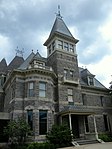The Palisades (Hudson River)

The Palisades, also called the New Jersey Palisades or the Hudson River Palisades, are a line of steep cliffs along the west side of the lower Hudson River in Northeastern New Jersey and Southeastern New York in the United States. The cliffs stretch north from Jersey City about 20 miles (32 km) to near Nyack, New York, and visible at Haverstraw, New York. They rise nearly vertically from near the edge of the river, and are about 300 feet (90 m) high at Weehawken, increasing gradually to 540 feet (160 m) high near their northern terminus. North of Fort Lee, the Palisades are part of Palisades Interstate Park and are a National Natural Landmark.The Palisades are among the most dramatic geologic features in the vicinity of New York City, forming a canyon of the Hudson north of the George Washington Bridge, as well as providing a vista of the Manhattan skyline. They sit in the Newark Basin, a rift basin located mostly in New Jersey. Palisade is derived from the same root as the word pole, ultimately from the Latin word palus, meaning stake. A "palisade" is, in general, a defensive fence or wall made up of wooden stakes or tree trunks. The Lenape called the cliffs "rocks that look like rows of trees", a phrase that became "Weehawken", the name of a town in New Jersey that sits at the top of the cliffs across from Midtown Manhattan.
Excerpt from the Wikipedia article The Palisades (Hudson River) (License: CC BY-SA 3.0, Authors, Images).The Palisades (Hudson River)
Long Path,
Geographical coordinates (GPS) Address Nearby Places Show on map
Geographical coordinates (GPS)
| Latitude | Longitude |
|---|---|
| N 40.96451 ° | E -73.90859 ° |
Address
Long Path
Long Path
07620
New Jersey, United States
Open on Google Maps







